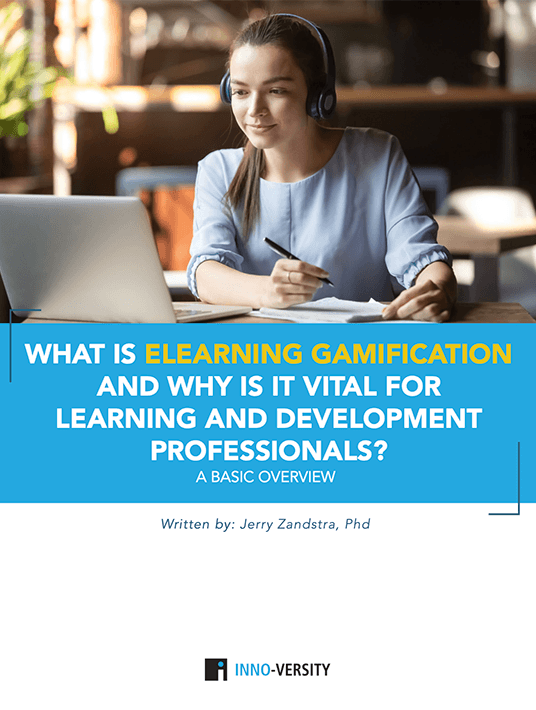How-To Guide For L&D Including The Top eLearning Gamification Examples
Introducing play in learning is the essence of gamification. Thankfully, there are thousands of ways to play. Human beings are remarkably creative when it comes to making games. This article will introduce key eLearning gamification examples by sharing game techniques, types, and activities. It is meant as a starting point for a framework that will assist those who want to get started on engaging learners in a game.

Why The Following eLearning Gamification Examples Can Lead To Training Success
By their very nature, the obstacles overcome and the rewards won are not real in a game. But playing in an artificial environment enables learners to strengthen their skills and decision-making abilities and apply these tools in the real world. As learners have fun and play the game, the objectives are readily achieved.
At the most basic level, most games contain some version of the following 5 critical elements:
1. Goals
Every game has something that needs to be achieved by the player or players. It might be a quest to be achieved or a problem to be fixed or a puzzle to be solved. Goals are destinations that keep players on track.
2. Rules And Limitations
For a game to function properly, it needs simple, efficient, and consistent rules. Even when a player is not aware of all the rules at the start, they need some basic understanding of how the game gets underway. Games without rules will simply frustrate players. In general, rules provide time constraints. They also clarify the impact of making a correct or incorrect choice, although surprises can be an effective means of re-engaging a learner. Like life, there is often an element of randomness or even luck involved—think of cards being dealt. That’s what makes games—and life—interesting.
3. Decision Or Action Points
Decisions are the most obvious interactive part of a game. Learners are presented with choices and must make a decision. Each decision has a set of consequences. The decision points can be obvious and straightforward or ambiguous. In that way, the outcome is not immediately known but will be made clear as the game progresses. Decisions can be individual or collective. Often, decisions vary in their level of difficulty as the game advances.
4. Game Mechanics
These are the options for how the learner navigates through the game environment. Players can take turns or compete against a clock. This is often accomplished by the use of timers, various game-based “powers” available to the learner, and levels of progress toward the goal. In some games, there are player statistics and, if played by a group, leaderboards that make it obvious how one player stands in relation to competitors.
5. Feedback System
Learners need to know where they are in the game and how well they are doing compared to stated goals. Helpful feedback should be timely and meaningful. It can even be humorous or surprising. Feedback can be directed to individuals or teams of players. It is often given in real time and may last only a second. While there are many options for feedback, some of the most common forms are visual and sound effects, scoreboard, doors or paths that open, or gaining powers or abilities when successfully completing a portion of the game.
Which eLearning Gamification Examples Should L&D Teams Leverage?
These are the basic elements of most games. With them, it is possible to create hundreds of types of games. While not meant to be exhaustive, there are several types of games and gamified activities from which designers can make choices:
- Puzzles
At their core, puzzles are problem-solving activities. Puzzles have patterns that enhance the ability to be logical and patterned in the approach to problem-solving. Crossword puzzles are a classic example of this activity, as is the Portal single-player game, which requires participants to solve physical puzzles and challenges by opening portals to maneuvering objects, and themselves, through space. - Adventure
A player may begin with a backstory that clarifies both the character and the mission of the game. The Legend of Zelda has a compelling backstory written into it. To win an adventure game, the player must complete the mission. Often the mission is made up of multiple levels. Players interact with the game by making decisions at various points throughout the game. - Role-playing games
Most often, the learner becomes the protagonist in a story and plays a prominent and determinative role in the outcome of the story. Often, the learner makes choices to save, defend, or advance in a realm. The overview for the Assassin’s Creed Odyssey invites us to “live the epic odyssey of a legendary Spartan hero.” - Strategy games
These games focus on tactics rather than randomness or luck. The tactics often center on skillful thinking and careful planning, often with incomplete information so that they simulate real life. Chess is the model here. A more recent example is "Settlers of Catan," the popular multiplayer board game. - Action
Players win by defeating an enemy with quick action and fast reflexes rather than more deliberate planning and strategy. Halo, in which players battle various aliens, comes to mind immediately. - Simulation
Rather than creating an artificial environment, the game is created to closely mimic real life. How it is played can vary, but the idea is to create a set of circumstances that are closely aligned to someone’s actual circumstances and surroundings. The Sims game, which simulates the daily life of people, is a well-known example of this. - Emergent games
In emergent games, the learner makes simple decisions that lead to cumulative complex outcomes. Many are branching exercises that lead to a variety of endpoints that can be positive or negative. In such games, such as Grand Theft Auto, the exercises change based on learner decisions.
Sum It Up
Let’s close this chapter with some tips on game design. It is important that each of the critical elements above is included when gamifying learning assets. Missing elements, such as unclear rules or the lack of an objective, will be frustrating to a player who will quickly lose interest and may simply give up. Be clear on the type of game or gamified activities you’re incorporating into the learning. It is certainly possible to make use of multiple game types.
The best games advance the learning objective, present an aesthetically interesting (even beautiful) environment, are easy to learn but challenging to master, and are efficient in the use of learners’ time. Most of all, they’re fun! Download the eBook What Is eLearning Gamification And Why Is It Vital For L&D Professionals? to discover how to bring eLearning gamification to your learning with solid theory and great case studies. Also, join the webinar on the same topic and find out how to create a winning eLearning gamification strategy.










